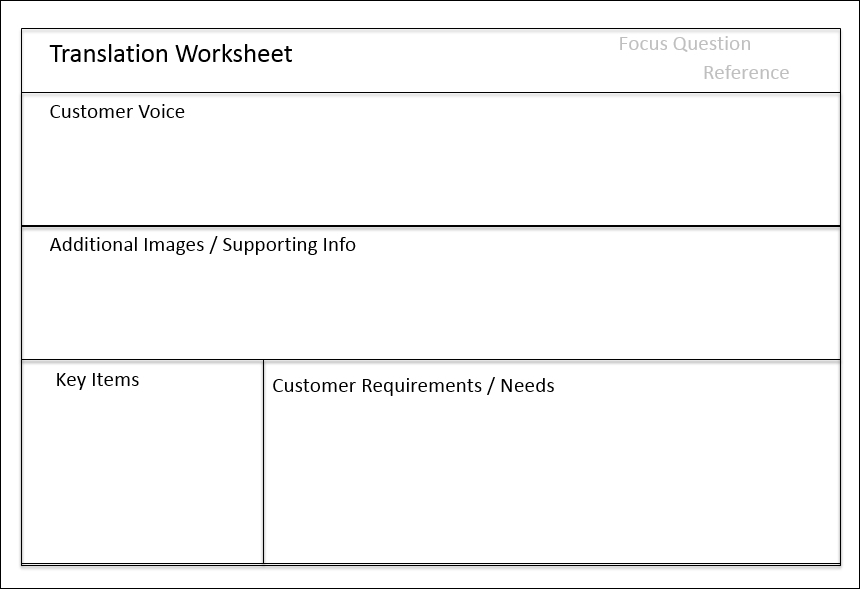You have now limited your focus on the 20-30 most pressing customer voices. You now need a way to group these disparate thoughts and images into a cohesive set of requirements that can be deployed in your new development. Have everyone review the yellow sticky notes that were picked. You should now have a robust set of customer voices from your interviews and you should begin to develop a sense of your customers' main concerns and requirements.
We now need a method to convert your customers' voices, key concerns, and images into requirements. For this we will use a "translation worksheet." This tool allows us to reframe each customer voice into specific performance requirements for the product or service you are investigating. This part of the process is critically important. Customers often describe their needs in vague language or in terms that they are already familiar with, or even worse, they tell you the solution they need. This step helps us to identify the requirements necessary to develop the solution the customers actually require.
To begin, we will take the final set of yellow sticky notes and transfer the customer statements or voices onto the translation worksheet as shown in Figure 7.6. You will create a worksheet for all the voices. If you are translating all voices into customer requirements, you may also wish to split up into teams to do the translation work as it can take a fair amount of time:

Figure 7.6
The following is a description of each section of the translation worksheet:
- Focus question: You need some way to link this worksheet to the focus question you are trying to address. Stating the focus question as part of the sheet or some other way to group these worksheets is good practice.
- Reference: Having some way of going back to your notes or yellow sticky notes is also good practice and should be adopted as part of your process. It is simple to transfer the reference from your yellow sticky directly to the worksheet that addresses this need.
- Customer voice: This is a verbatim sentence, statement, phrase, or group of sentences taken from the yellow sticky note.
- Images: Add any additional images that you saw or heard during the customer interview or site visit that supports the customer's voice. Sometimes, this image can be constructed by the team as they visualize themselves in the customer's world and doing what the customer does.
- Key items: These can be any issues or considerations that come to mind when you think about this specific customer voice. Key items often serve as the link between the customer voice and the actual requirement statement. There are no hard and fast rules about what is or is not a key item. Use this area on the worksheet to free-associate recording key words, sentences, or other images that come to mind. This area can also include outside items such as research reports and historical data and analysis in support of the customer's voice.
- Customer requirements/needs: This is a concise one-sentence statement that clearly describes the function or product attribute you will need to address the customer voice. It is likely that you will need more than one requirement statement to address the customer voice.
Before filling out the customer requirements/needs section, it is good to step back and review the types of needs and what makes up a good requirement. A good customer requirement/needs statement should have the following criteria:

Figure 7.7
Writing a good requirement statement often takes multiple iterations. It is often helpful to write down your first impression of a requirement statement and then attempt to refine it to meet the requirement statement criteria in Figure 7.7. It is also good practice to ensure you do not use "and" in your requirement statements. The use of "and" usually indicates more than one customer requirement.
The following example illustrates a customer requirement for a ruggedized laptop:

Figure 7.8
As you can see from the translation worksheet, the quote from the customer was not enough to determine the customer requirement/need, but by understanding the other things the customer said, as well as seeing the customer's site, we were able to create a much more robust image than with the customer voice alone.
As you are undertaking this exercise, do not be surprised if you interpret customer requirements differently than others on your team. We have different perspectives and have interviewed different customers, so this should not be a surprise. Explore these differences and, if necessary, create two requirements. Again, it is more than likely you will get multiple requirements from a customer voice and these opportunities should be fully vetted as part of this exercise.
It is also worth noting that you will often uncover potential solutions as you are performing this analysis. Do not try and force these solutions into requirements; simply put them aside for review later in the process.
When you are finished with your translated worksheet, move on to the next one. If you get stuck on a particular worksheet, put it aside and come back to it later.
